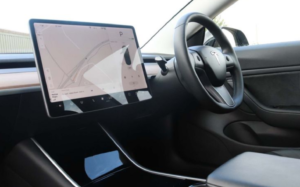Venice, 2017.
Quote of the Day
“There’s so much denial going on about how aerosols are the principal cause of spread. It’s quite weird. Think of coronavirus as infectious smoke, with some heavy smokers and lots of very light smokers, and you’re there. The problem: you can’t tell who the heavy smokers are.”
Musical replacement for the morning’s radio news
Glenn Gould – J.S. Bach, Variazioni Goldberg – 1981
Excel spreadsheet error blamed for UK’s 16,000 missing coronavirus cases
There’s been a huge hooh-hah (understandably) about the error that left large number of virus cases unreported. But, as this account by The Verge may suggest, many users of the Microsoft Excel spreadsheet may have the “there-but-for-the-grace-of-God-go-I) feeling. We’ve all screwed up on Excel at one time or another.
The 15,841 “missing” cases made public today were originally recorded between September 25th and October 2nd. All those who tested positive for COVID-19 were notified by the UK’s health authorities, but the failure to upload these cases to the national database meant anyone who came into contact with these individuals was not informed. It’s an error that may have helped spread the virus further through the country as individuals exposed to the virus continued to act as normal.
According to reports from The Guardian and Sky News, the mistake was caused when PHE tried to collate data from multiple sources in the form of CSV files by loading them into Excel. This popular spreadsheet software has limits in how many rows it can load — 65,536 rows in older versions and 1,048,576 rows in more recent versions. Based on these reports, it’s not clear which version of Excel PHE is using, but the row-limit was reached regardless. As PHE workers tried to load more cases into the national database, they were rejected.
The solution, at least, is as simple as the error, and the overly large files have reportedly now been split into smaller batches. PHE didn’t confirm this but says the problem is now resolved, and that it passed the details of the backlog of confirmed cases onto the UK’s contact tracers as of 1PM local time on Saturday.
It reminds of an adage that I used to cite in the early days in defining ‘Big Data’ — which was the amount of data that wouldn’t fit on an Excel sheet.
HT to Ian Clark.
More than tools: who is responsible for the social dilemma?
The Social Dilemma is Jeff Orlowski’s much-discussed film about the toxic impact of social media on society, and particularly on young people. I wrote about it in my Observer column a few weeks ago.
For those of us who have for years been trying – without notable success – to spark public concern about what’s going on in tech, it’s fascinating to watch how a talented movie director goes about the task. Orlowski adopts a two-track approach. In the first, he assembles a squad of engineers and executives – people who built the addiction-machines of social media but have now repented – to talk openly about their feelings of guilt about the harms they inadvertently inflicted on society, and explain some of the details of their algorithmic perversions.
They are, as you might expect, almost all males of a certain age and type. The writer Maria Farrell, in a memorable essay, describes them as examples of the prodigal techbro – tech executives who experience a sort of religious awakening and “suddenly see their former employers as toxic, and reinvent themselves as experts on taming the tech giants. They were lost and are now found.”
Biblical scholars will recognise the reference from Luke 15. The prodigal son returns having “devoured his living with harlots” and is welcomed with open arms by his old dad, much to the dismay of his more dutiful brother. Farrell is not so welcoming. “These ‘I was lost but now I’m found, please come to my Ted Talk’ accounts,” she writes, “typically miss most of the actual journey, yet claim the moral authority of one who’s ‘been there’ but came back. It’s a teleportation machine, but for ethics.”
It is, but Orlowski welcomes these techbros with open arms because they suit his purpose – which is to explain to viewers the terrible things that the surveillance capitalist companies such as Facebook and Google do to their users. And the problem with that is that when he gets to the point where we need ideas about how to undo that damage, the boys turn out to be a bit – how shall I put it – incoherent.
Now comes a really insightful commentary by Niall Docherty from the Social Media Collective, a network of social science and humanistic researchers who work in the Microsoft Research labs in New England and New York.
“While the film’s topic is timely, and explored with applaudable intentions,” he writes,
“its subject matter is mishandled. For all of its values, and all of its flaws, the film’s diagnosis of social media is based on a fundamental misunderstanding of technology. Its recommended path to recovery, as a result, leads to a dead-end. Until we think of technology not as a tool but as a set of relations, we will never truly grasp the problems with which The Social Dilemma is concerned.”
He takes issue with the core argument of the film, namely that social media are designed to manipulate their users for corporate gain. But, says Docherty,
To be “manipulated” suggests that users are being diverted from a course of action they would otherwise have taken. This implies a pre-existing individual, already happily furnished with their own desires, and with full capacity to enact them as they please. Social media, in this framework, is the diverting, deceiving technology that takes individuals away from their “true” interests. By falling prey to the nudges of social media, and giving in completely to what they are predicted to want, users are stopped from acting wilfully, as they otherwise would.
Yet when have human beings ever been fully and perfectly in control of the technologies around them? Is it not rather the case that technologies, far from being separate from human will, are intrinsically involved in its activation?
French philosopher Bruno Latour famously uses the example of the gun to advance this idea, which he calls mediation. We are all aware of the platitude, “Guns don’t kill people, people kill people”. In its logic, the gun is simply a tool that allows the person, as the primary agent, to kill another. The gun exists only as an object, through which the person’s desire of killing flows. For Latour, this view is deeply misleading. Only when the human intention and the capacities of the gun are brought together can a shooting actually take place. So responsibility for the shooting, which can only occur through the combination of human and gun, and by proxy, those who produced and provided it, is thus shared.
With this in mind,
we must question how useful it is to think about social media in terms of manipulation and control. Social media, far from being a malicious yet inanimate object (like a weapon) is something more profound and complex: a generator of human will.
This is an interesting approach to the problem which addresses the thorny question of why — if social media is so bad for people — do they continue to use it. It will annoy some people, I guess, because they will see it as letting the tech companies off the hook. But it also forces one to re-evaluate one’s own preconceptions. Which of course is also what Bruno Latour does for a living!
GOP Elites Thought They Could Buy Exemption From a Pandemic
Twitter user Kate Bennett tweeted an extraordinary film clip of the White House Rose Garden party to celebrate Trump’s nomination of a reliable right-wing lawyer to the Supreme Court.
The video clip in the link is worth watching in the context of this piece in NYMag:
It is too early to know with certainty that the Barrett nomination party was a superspreader event. But we do know that at least eight of the event’s attendees have now tested positive for COVID-19. And we also know that the White House might as well have hired the novel coronavirus as its party planner, the proceedings were so well-tailored to the bug’s spread (a throng of people speaking indoors, in close proximity, without masks, for an extended period of time). So it seems safe to assume that the event played some role in the cluster of infection that has put Donald Trump and Chris Christie in the hospital, much of Mitch McConnell’s caucus in quarantine, and the broader population of Washington, D.C., at an increased risk of serious illness.
The White House told The Wall Street Journal Sunday that its officials and guests do not generally wear masks or practice social distancing “because they are tested daily.” This appears to confirm that all those serial huggers in the Rose Garden on September 26 did indeed believe their privileged access to rapid tests would exempt them from the hard facts of pandemic life.
All of which invites the question: Why didn’t they know better?
The answer, of course, is that — like elites everywhere — they think they can buy exemption from the virus. Mercifully, the virus knows better.
This blog is also available as a daily email. If you think this might suit you better, why not subscribe? One email a day, delivered to your inbox at 7am UK time. It’s free, and there’s a one-click unsubscribe if you decide that your inbox is full enough already!


